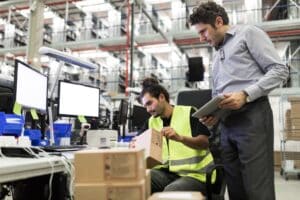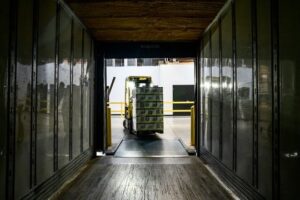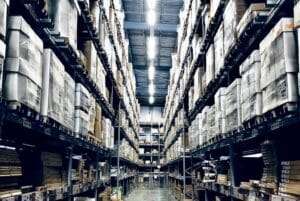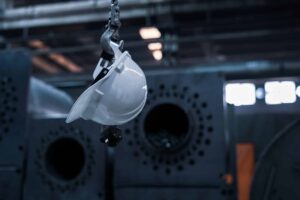AMR vs. AGV: Which mobile robot will boost your warehouse?
Logistics
4.0 solutions
Supply Chain
September 19, 2025
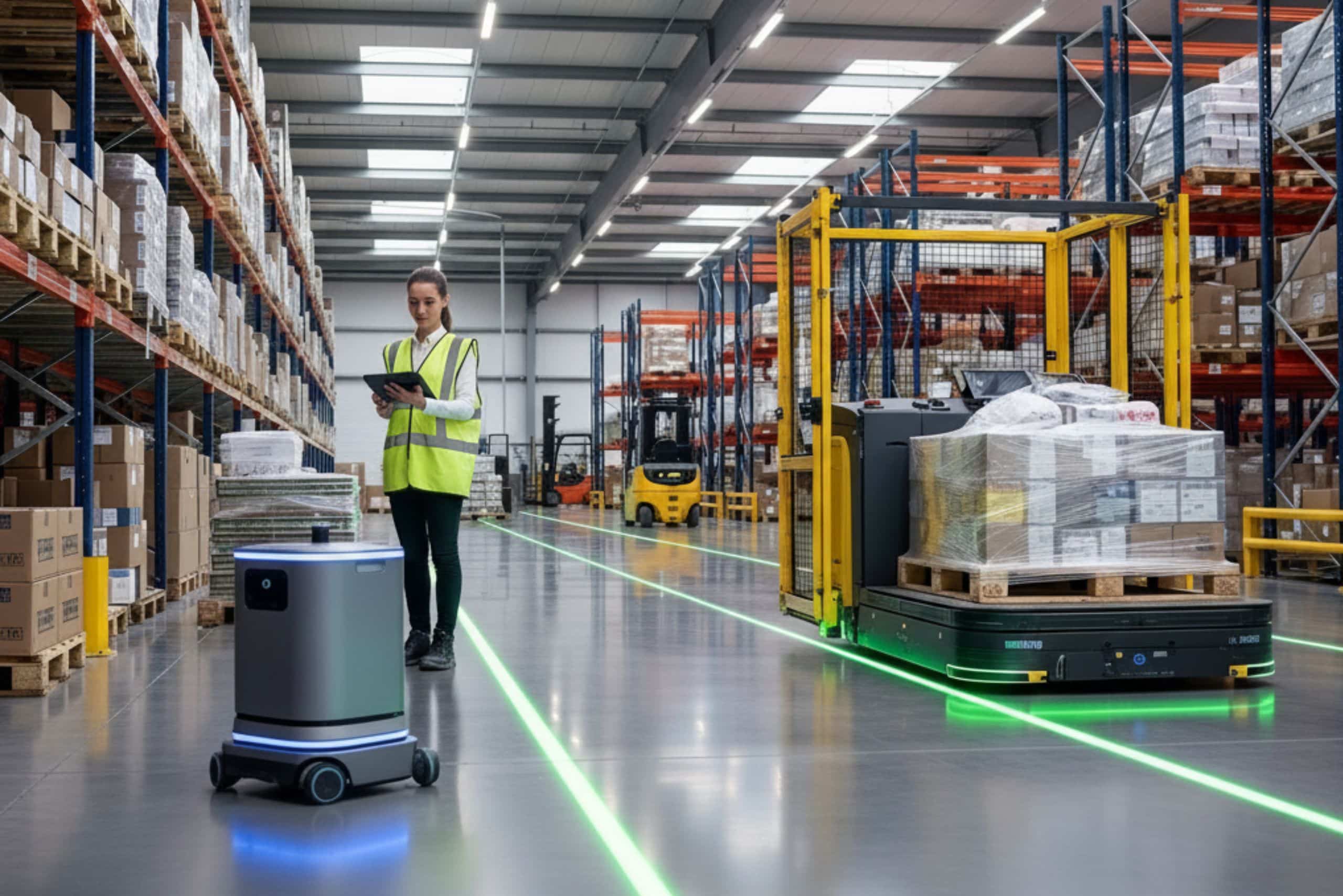
The pressure on warehouses has never been greater. The explosion of e-commerce, the demand for ever-faster deliveries, and labor shortages... Every day presents a new challenge.
In this race for performance, automation is no longer an option, but a necessity. And at the heart of this revolution are mobile robots.
The market is full of models and technologies, but not all are equal. The question then arises: should we opt for AGV (Automated Guided Vehicles) robots, the pioneers of automation, or AMR (Autonomous Mobile Robots), their intelligent and agile successors?
This decision can radically transform your logistics flows. It will impact your productivity, flexibility, and ultimately, your profitability.
So, how do you make the right choice? This article will guide you step by step so you can select the technology that will truly power your warehouse .
Dive into the heart of mobile robotics: Two philosophies, two technologies
Before contrasting them, it's essential to understand the fundamental differences between an AGV and an AMR. While they both serve to automate the transportation of goods, their approach to navigation and interaction with their environment is radically different.
AGVs (Automated Guided Vehicles): Structured Reliability
AGVs are the elder states of intralogistics. First appearing in the 1950s, they are designed for a simple and essential task : following a predefined path with unfailing reliability.
Imagine a train on its tracks. It cannot deviate from its track. The AGV works on the same principle. Its navigation is wire-guided, which means it follows physical lines (magnetic strips, cables embedded in the ground) or virtual paths defined by laser reflectors.
Their main mission: transporting heavy loads over fixed, repetitive distances. They are tireless as long as their path is clear.
Their intelligence is limited: if an obstacle appears in their path, they stop and wait for it to be removed . They cannot take initiative. This simplicity is both their strength—proven reliability and security—and their greatest weakness.
AMRs (Autonomous Mobile Robots): Intelligence and flexibility
AMRs represent a major technological leap forward, driven by advances in artificial intelligence, computer vision, and advanced sensors.
If the AGV is a train, the AMR is a self-driving car. It doesn't need rails. It maps its environment using technologies like SLAM (Simultaneous Localization and Mapping)—the same technology used by robot vacuum cleaners—and navigates dynamically.
Thanks to its sensors (LiDAR, 3D cameras, security scanners), the AMR "sees" and "understands" its environment in real time . It can identify obstacles, whether fixed (shelves) or mobile (an operator, an order picker), and navigate around them by instantly recalculating the best route.
This adaptability makes it ideal for complex and changing environments, typical of e-commerce warehouses where order fulfillment is intense and flows unpredictable. They are designed to collaborate with humans in complete security.
The technology match: AGV vs. AMR, the detailed comparison to make the right choice
Choosing between these two technologies should be guided by a careful analysis of your needs, your environment, and your long-term goals. Let's analyze their key points.
Navigation and Flexibility: Agility vs. Rigidity
This is the most discriminating criterion.
AGV robots offer almost zero flexibility . Their path is set in stone (or rather, in the warehouse floor). Changing a route involves work, a shutdown, and significant costs. A single box falling onto their path is enough to paralyze part of the flow. This rigidity is incompatible with operations that require constant adaptation .
AMR robots , on the other hand, are flexibility personified . Their initial deployment involves a "mapping" phase where the robot travels through the warehouse to create a digital map. Once this map is recorded, the fleet management system can dynamically assign them missions. If the warehouse layout changes, a simple map update is enough. When faced with an obstacle, they don't stop; they go around it. This agility allows for much better management of logistics flows in real time and ensures continuity of operations .
Installation and deployment: Weeks of work versus a few hours of configuration
Deploying an AGV is an infrastructure project. Magnetic strips, cables, or laser reflectors must be installed. This can take several weeks or even months and often requires shutting down the affected area.
Deploying AMRs is radically simpler and faster. SLAM technology allows robots to map the warehouse in a matter of hours, often without disrupting ongoing operations. Installation is therefore primarily software-based . This speed of implementation is a considerable advantage for companies that cannot afford long downtimes.
Costs and Business Model: Initial Investment vs. Total Cost of Ownership (TCO)
At first glance, an AGV robot is often less expensive to purchase than an AMR robot with more complex technologies. However, this view is misleading.
The real cost of an AGV project includes the purchase of the vehicles AND the very high cost of installing and modifying the warehouse infrastructure . Each subsequent change to the route will incur additional costs.
AMRs, while more expensive per unit, require virtually no infrastructure costs. Investment is focused on the onboard technology. Their flexibility also avoids the costs associated with future reconfigurations. In the long term, in a dynamic environment, the total cost of ownership (TCO) of an AMR fleet is often more advantageous.
Human-Machine Security and Collaboration
Both technologies are safe. AGVs have basic safety scanners that instruct them to stop if an obstacle is detected. They are safe, but not very collaborative.
AMRs, on the other hand, are designed for interaction. Their 360° sensors and onboard intelligence allow them not only to detect a human, but also to anticipate their trajectory and seamlessly avoid them, slowing down or veering around them, without necessarily coming to a complete stop. This creates a more harmonious and productive work environment where humans and machines collaborate.
Use case: Each robot has its own mission
The choice will ultimately depend on the tasks you want to automate.
Ideal use cases for AGVs:
- Pallet transport: Transfer of heavy and standardized loads between fixed points (e.g. from the end of the production line to the storage area).
- Repetitive processes: Tasks that never change, in a stable and predictable environment.
- Low human interaction environments.
Ideal use cases for AMRs:
- Order preparation (" Picking "): This is their preferred field. Goods-to-Man systems, where AMRs bring shelves directly to operators, have become a standard for efficiency. They drastically reduce the number of trips made by pickers.
- Replenishment of picking: Transport of pallets from the reserve to the picking aisles.
- Sorting and shipping: Moving sorted packages to the corresponding shipping docks.
Dynamic environments: E-commerce warehouses, 3PLs , where product references (SKUs) and layout change often.
Integration with your WMS: The brain of your automation operation
Buying a fleet of mobile robots without fully integrating them with your information system is like buying a race car without wheels. The raw performance is there, but you can't steer it. In your case, the driver of your warehouse is your Warehouse Management System (WMS).
Why is WMS software the backbone of automation?
Your warehouse management software, or WMS, is much more than just inventory management software. It's the brain that drives your entire operation . It oversees inventory management, storage management , and most importantly, it orchestrates order fulfillment.
Yes, it's the WMS platform that receives customer orders, locates products in the warehouse, and decides on the most efficient picking order. For a fleet of robots to be efficient, it must receive its orders directly from the WMS.
Without integration, you would be forced to manually manage robot missions, thus destroying all productivity gains. Good integration allows the WMS to communicate mission orders ("pick up product X from location Y and bring it to packing station Z") directly to the robot fleet management system.
This synergy is synonymous with perfect traceability and optimized logistics flow management.
Checklist for a successful WMS-Robots integration
Integration is a step that should not be overlooked. Here's a roadmap to help you avoid missing anything.
- Step 1: Audit your current WMS.
- Does it have open and documented APIs (Application Programming Interfaces) that allow easy communication with third-party systems? An aging or “closed” WMS can make integration complex and costly, if not impossible.
- Step 2: Define the data flows precisely. What information needs to flow between systems? Typically:
- Picking, replenishment and storage orders.
- Confirmation of pick-up, drop-off,
- Robot status, alerts.
- Step 3: Involve operational teams. Your order pickers and warehouse managers are best placed to describe current workflows. Automation should enhance their processes, not replace them.
- Step 4: Choose a robot supplier with strong integration expertise. The AMR/AGV manufacturer should be able to demonstrate experience with your type of WMS or, at a minimum, similar systems. Ask for case studies.
- Step 5: Plan rigorous testing phases. Don't switch over your entire warehouse at once. Start with a pilot area. Test all possible scenarios: peak activity (link: peak activity management), error handling, outages, etc.
- Step 6: Train your teams. Operators will need to learn how to interact with the robots and use the new software interfaces. Change management is essential for project adoption and success.
Calculate the Return on Investment (ROI) of your robot fleet
Investing in mobile robotics is a strategic decision that must be justified by calculating ROI.
Costs to consider
For a good analysis, it is necessary to include all direct and indirect costs:
- Acquisition cost: The price of the mobile robots themselves.
- Infrastructure cost (especially for AGVs): Floor markings, reflectors, etc.
- Software cost: Licenses for the fleet management system, and potentially the costs of upgrading or developing your WMS software.
- Integration Cost: The budget for professional services that will connect the WMS and robots.
- Maintenance and support cost: Annual contracts to ensure the proper functioning of hardware and software.
- Training cost: The time required to train your teams on these new automated inventory management tools.
The gains to be quantified
This is where investing makes sense:
- Productivity gains: This is the most direct gain. A Goods-to-Man system based on AMRs can multiply by 2, 3 or even 5 the number of order lines prepared by an operator per hour, simply by eliminating travel time.
- Reduced picking errors: Automation drastically reduces human error, which lowers the cost of returns and improves customer satisfaction.
- Improved safety: Fewer movements of manual equipment such as the order picker means less risk of accidents.
- Optimization of storage area: Some robotic systems allow for greater storage density, delaying the need to expand the warehouse.
- Flexibility and scalability: It is easy to add robots to the fleet to manage peak activity (Black Friday, sales) and remove them during off-peak periods (RaaS model – Robot as a Service).
When to invest? The signs that don't lie
Wondering if it's the right time? Here are some indicators:
- Your order picking error rate is too high and is costing you dearly.
- You can't keep up during seasonal peaks.
- Costs related to workplace accidents are a concern.
- Your competitors are automating and becoming more efficient.
- You want to make your logistics a competitive advantage by building a real warehouse of the future.
Building Your Warehouse of the Future: Beyond AGV and AMR
The vision of the warehouse of the future is not a binary opposition between AGV and AMR, nor a total replacement of humans. It is an intelligent synergy between different technologies and human skills.
Synergy of technologies: The best of both worlds
In very large warehouses, it is entirely possible to have both technologies coexist . AGVs could be used for mass transport over long straight distances (e.g., for picking replenishment), while a fleet of AMRs would handle more complex, higher-value tasks in dense picking areas.
The orchestration of this cohabitation is ensured by the WMS which assigns the right task to the right robot . This is where strategies like ABC classification (or abc classification) take on their full meaning. The WMS, knowing the products with the highest turnover (class A), can organize the storage and the robots' missions to minimize travel distances and maximize efficiency.
The future is collaborative (“Cobotics”)
The ultimate goal isn't a warehouse without humans, but one where operators perform more high-value tasks thanks to technology . AMRs are at the forefront of this "cobotics" (collaborative robotics) trend. They take on the most arduous, repetitive tasks, such as long trips.
This allows operators to focus on tasks that require their intelligence and dexterity: quality control, complex packaging, exception handling. Work becomes less physical, safer, and more rewarding.
AGV for structure, AMR for agility: Your warehouse, your choice.
The decision between AGV robots and AMR robots is not a simple technological choice. It is a strategic decision that must be aligned with the nature of your operations, your environment, and your vision for the future.
To summarize:
- Choose AGVs if your flows are stable, standardized, repetitive and you are looking for a proven solution for point-to-point transport of heavy loads in a low-change environment.
- Turn to AMRs if your warehouse is dynamic, if you manage a large number of references, if flexibility is your priority and if you aim for close and safe collaboration between humans and robots, particularly for complex tasks.
The success of your project will not only depend on the robot, but also on the intelligence of the ecosystem that drives it. Seamless integration with a powerful WMS solution is the real driver of your supply chain optimization .
Ready to take your logistics to the next level? Automation is within your reach.
Contact us for a warehouse audit. We'll analyze your workflows together and determine the mobile robotics solution that best meets your challenges and transforms your performance.
FAQ: Everything you need to know about mobile robots
Can an AGV be converted into an AMR?
No, they are two fundamentally different technologies. An AGV is designed to follow predefined lines or paths. An AMR uses advanced sensors and AI to navigate freely. It is not possible to “upgrade” an AGV to an AMR; that would mean completely changing its navigation system, sensors, and control software—the equivalent of building a new robot.
What is the average lifespan of a mobile warehouse robot?
The lifespan of an AGV or AMR is generally several years, often between 7 and 10 years, or even more. This depends on the intensity of its use, the quality of its manufacture and, above all, the rigor of preventive maintenance (checking batteries, sensors, wear parts).
Does AMR installation require a complete warehouse shutdown?
No, and that's one of their great advantages. Deployment is a two-step process: mapping, where the robot walks the aisles to create its map (which can often be done outside of peak hours), and software integration. Routine operations can usually continue with minimal disruption during installation.
Are AMR robots really safe to work alongside humans?
Yes, safety is their priority. AMRs are equipped with multiple sensors (certified security scanners, 3D cameras) that give them a 360° view of their surroundings. They can detect the presence of a person several meters away, anticipate their trajectory, and adapt their speed and path to avoid them smoothly and predictably.
What is the impact of artificial intelligence (AI) on AMR performance?
AI is at the heart of AMR's superiority. It intervenes on several levels:
- Navigation (SLAM): AI allows the robot to locate itself precisely and understand the geometry of the warehouse.
- Obstacle Avoidance: AI algorithms analyze sensor data in real time to make the best avoidance decisions.
- Fleet optimization: The system uses AI to distribute tasks among robots in the most efficient way possible, minimizing empty runs and preventing congestion.
Most read articles
Logistics
4.0 solutions
Supply Chain
September 19, 2025
AMR vs. AGV: Which mobile robot will boost your warehouse?
The pressure on warehouses has never been greater. In the race for performance, automation is no longer an option, but a necessity. And at the heart of this revolution are mobile robots. But how do you make the right choice?
WMS software
Logistics
Supply Chain
September 29, 2025
Hazardous Materials Management: How Does a WMS Ensure Compliance and Safety?
Managing flammable, toxic, corrosive, or explosive products isn't just a logistical constraint; it's an immense responsibility, governed by highly complex regulations. Indeed, managing hazardous materials is a daily challenge that leaves no room for improvisation.
WMS software
Logistics
Supply Chain
October 3, 2025
Making your cross-docking project a success: Steps, tools and pitfalls to avoid for a successful transition
Imagine: your goods arrive at the dock, are immediately sorted, and almost immediately depart for their final destination—all in less than 24 hours. No more unnecessary storage costs, no more shortages due to dormant inventory. That's the promise of cross-docking.
